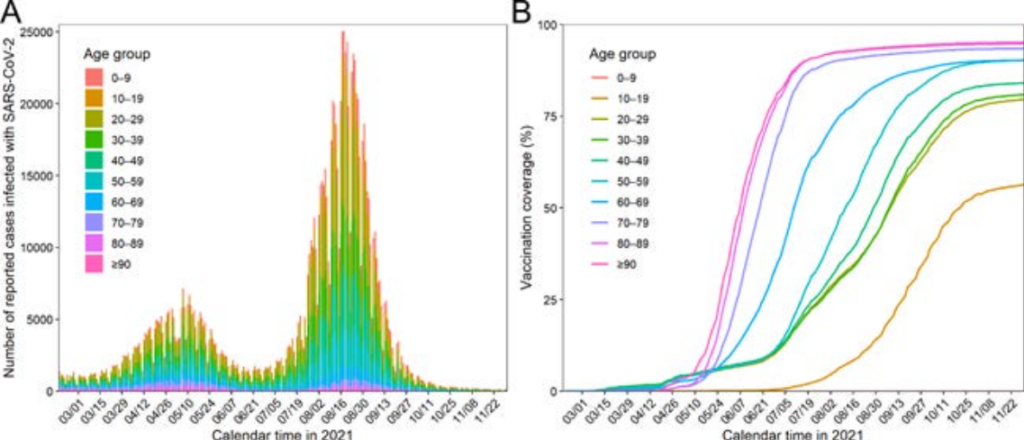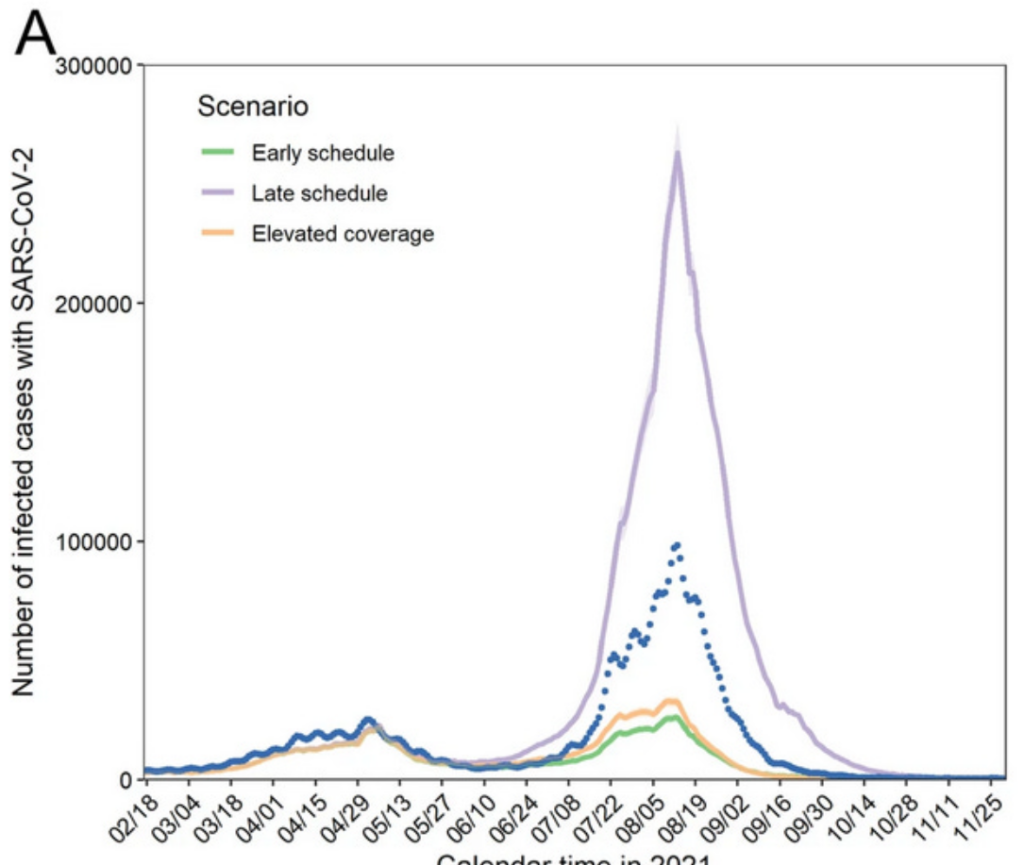Just when I thought I might never have to write about the COVID-19 Pandemic in Japan again, the Nature journal Scientific Reports publishes a hallucinogenically ludicrous counterfactual modelling study co-authored by Hiroshi Nishiura, the Japanese Government’s go-to guy for epidemiological modelling madness.
I didn’t think Nishiura would ever again produce anything as insane as his 2020 prediction of “420,000 dead without social distancing” but it looks like I underestimated him.

Here’s the abstract to the study ‘Evaluating the COVID-19 vaccination program in Japan, 2021 using the counterfactual reproduction number‘ (emphasis added).
Japan implemented its nationwide vaccination program against COVID-19 in 2021, immunising more than one million people (approximately 1%) a day. However, the direct and indirect impacts of the programme at the population level have yet to be fully evaluated. To assess the vaccine effectiveness during the Delta variant (B.1.617.2) epidemic in 2021, we used a renewal process model. A transmission model was fitted to the confirmed cases from February 17th to November 30th 2021. In the absence of vaccination, the cumulative numbers of infections and deaths during the study period were estimated to be 63.3 million (95% confidence interval [CI] 63.2-63.6) and 364,000 (95% CI 363-366), respectively; the actual numbers of infections and deaths were 4.7 million and 10,000, respectively… We demonstrated the very high effectiveness of COVID-19 vaccination in Japan during 2021, which reduced mortality by more than 97% compared with the counterfactual scenario.
Put simply, Nishiura et al. input a load of outlandish assumptions into their model to make it estimate that without the jabs, about 50% of the population would have been infected and 0.3% of the population would have died of Covid during the Delta wave alone. The nicest thing I can say is that they clearly omitted the assumption that Japan’s 100% mask rate made a difference.
The authors’ utter unseriousness is evidenced by them including real-world data in the paper that completely refutes the model’s output, such as the below figure from the paper’s supplementary material. The Delta wave is the large second peak in that year – does it look like the jabs prevented 92.6% of possible infections during the Delta wave in summer 2021?

After looking at the above figure, anyone who still regards peer-review as a guarantor of quality might want to consider why neither the authors nor apparently the peer-reviewers bothered to ask the obvious and pertinent question, “Why were cases much lower in the Alpha wave when hardly anyone was jabbed?”
But the paper gets even more delusional. The authors came up with three more counterfactual scenarios with even less realistic results.
If the vaccination program had been conducted 14 days earlier than the actual pace, the peak of daily incidence would have decreased by 73%, i.e., 98,368 infections (or four times the observed) versus 26,149 (95% CI 24,354-27,952) infections in the early schedule scenario. However, if the program had taken place 14 days later than the actual schedule, the peak of daily incidence would have reached 263,220 (95% CI 250,387-276,173) infections, and the maximum daily incidence was estimated to be 33,004 (95% CI 30,996-35,258) infections in the elevated coverage scenario [i.e., higher coverage among people aged 10-59].
The ridiculousness of these estimates is evident from just looking at figure plotting them: the early schedule and extended coverage scenarios are almost identical to the Alpha wave before the jabs were made available to the general population, while the late schedule scenario is about 10 times higher.

The reason for publishing this nonsensical drivel becomes clear in the discussion.
In our elevated coverage scenario (i.e., encouraging more adolescents and people aged 10-59 years to be vaccinated), the total effect was substantial, even when older people were not prioritised for vaccination. This demonstrates that vaccinating younger individuals with substantial transmission potential is a critical strategy in mitigating the magnitude of the epidemic for an entire population, including children aged under 10 years who were not eligible for the vaccination programme.
Basically, by having Nishiura et al. publish a study in a supposedly reputable journal based on a make-believe model that “demonstrates” that jabbing the low-risk young protected the high-risk elderly in summer 2021, future Japanese Governments can point to this study to justify pressuring even more members of younger age groups to take warp speed jabs they don’t need during future viral scares.
It also means Fukuoka City will be able to make vax-sceptics want to puke their guts up again with yet another omoiyari wakuchin (vaccination out of consideration) poster.

One other problem with the idea that 50% of the country would’ve been infected with Delta if not for the glorious jabs is that most of the population was living under states of emergency and quasi-emergency, as advocated by Nishura. Is our rotund public health expert finally admitting that closing restaurants early and masking outdoors in 35-degree heat weren’t quite as effective as he and other experts previously claimed? Hardly.
Additionally, a surge in COVID-19 patients observed in July-September 2021 was the largest epidemic wave ever experienced in Japan, and the corresponding period fell under the state of emergency, which was based on a non-legally binding policy in which the Government requested voluntary restriction of contacts. Were PHSM [public health and social measures] not in place under the state of emergency, the number of infections could have been even greater than the observed number.
So the fourth state of emergency might not have looked very effective, but without it and the jabs, 70% or 80%, even 90% of the country would have been infected!

The pre-determined conclusion of this study can be summed up as follows: “No matter what the real-world data show, our model says the vaccines were magical. The only things we need to do differently next time are rubber stamp the shots’ approval earlier and jab more kids.”
As Covid has dropped out of the headlines, I often wonder if I’ll have anything more to write about. But as long as Nishiura and his ilk keep pumping out garbage like the above study, I guess I’m going to have to keep at it.
This article first appeared on Guy Gin’s Substack page, Making (Covid) Waves in Japan. Subscribe here.














To join in with the discussion please make a donation to The Daily Sceptic.
Profanity and abuse will be removed and may lead to a permanent ban.
He is a bought and paid for scientist,who,as you show,is not even competent.
Hat tip for the nom de plume.
Is Pantsdown assisting behind the scenes?
Interesting that 8 of the 9 models are pale-skinned!
Life’s too short to read this tosh!
Only God can “prevent death”. Humans can only postpone (or hasten) it. IMO any claim to “prevent death” is meaningless nonsense. You need to express your claims in terms of quality life years lost.
This paper is clearly a crock of excrement yet the science in question is still more respectable than climate modelling.
I’m sure he was paid handsomely and his career will sky rocket.
The excess deaths in Japan paint a very different picture than this ludicrous modelling. This type of government sponsored data manipulation needs to be exposed keep up the good work.